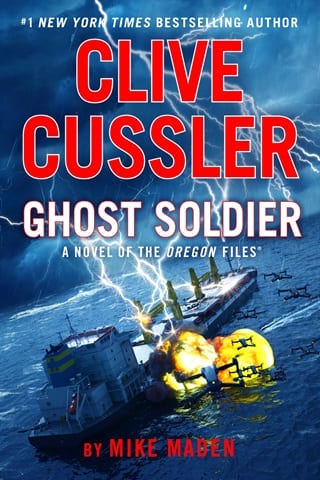Chapter 65
65
The Philippine Sea
124 Miles Northwest of Guam
Lieutenant Commander Xu believed in luck—but only the kind he could manufacture. His calculations had proven correct. American radar hadn’t yet discovered his small but deadly formation.
The ominously dark clouds and slashing rains brought joy to his soul, as did the whitecapping sea just fifty feet beneath his delta-shaped wings. The favorable weather conditions were playing havoc with the American defense systems, just as he had planned.
But it was the Mighty Dragon’s advanced stealth technologies that blinded them—at least so far. He and his wingman, Lieutenant Gao, were flying two of China’s newest and most advanced carrier-based fighters. Each of the twin-seated, twin-engined, fifth-generation J-20 aircraft were equal to anything in the sky, including the F-35 Lightning II, America’s most advanced fighter.
Xu’s and Gao’s two stealthy planes were loaded with China’s most advanced anti-radar, anti-aircraft, and anti-ship missiles. But the truly revolutionary technology they were deploying today was in the hands of the weapons systems officers, one seated in the backseat of each of their planes. The two weapons officers were each in charge of two AI-piloted drones, also loaded with missiles and other advanced combat technologies.
Because they had no pilots, the four drones had no need for armor, oxygen supplies, ejection seats, or any other life-support elements. This made them smaller and faster. But they still possessed all of the stealth technologies that made their larger “mother ships” invisible to the American electromagnetic spectrum. Combined with the smaller size, the drones were even stealthier than the J-20s they trailed.
Xu’s flight of two Mighty Dragon fighters and four drones had launched from China’s latest aircraft carrier, the Fujian, the first of several Type 003 vessels that would soon be coming online. Built like the USS Ford rather than the old “ski jump” Soviet design of its first two carriers, the Fujian was already altering the course of history.
Xu checked his pre-plotted course again. They were racing for Guam. If all went well, the Americans wouldn’t know what hit them until it was too late.
It was only a matter of time before the People’s Liberation Navy drove the Americans from the East China Sea. But it was Xu’s squadron, the Dao Ma Jian—the “Horse Cutters,” a famous Chinese battle-ax—that would soon achieve everlasting fame in the western Pacific.
★Captain Peter Stallabrass was in charge of the E-3 Sentry mission crew flying high above the Pacific. Built on the Boeing 707 airframe, the Sentry’s giant rotating radar dome covered two hundred fifty miles of air, ground, and sea surface.
The Sentry and its crew were on temporary loan from Kadena AFB in Japan, part of a buildup that included a flight of four F-35 Lightning IIs from Eielson AFB, Alaska. In recent weeks, China had been taking advantage of the fact that the United States had repositioned a vast number of Navy assets to the South China Sea over growing tensions with Taiwan. An invasion there seemed imminent. But it left Guam vulnerable.
Now the Chinese Navy was putting pressure on Guam, staging a large number of probing sorties against the strategically vital forward operating base. Chinese warships, submarines, and aircraft had made various runs at the island, testing its defenses, checking for weaknesses. Whether that was a feint to draw American forces away from Taiwan or an actual threat against Guam was something American intelligence analysts were still puzzling out.
Stallabrass had reached his own conclusions on the matter and drew up a will with an online lawyer before he accepted the transfer to Guam.
The island’s location in the far western Pacific was strategically important. Located some two thousand miles from the coasts of China and North Korea, its relative geographic remoteness made it less vulnerable to attack than American bases in Japan and South Korea.
Because of that remoteness, Guam had served as a near-perfect staging ground for America’s strategic bombers since World War II. And after the loss of Air Force and Navy bases in the Philippines in the 1990s, Guam’s strategic importance had increased exponentially. Bomber fleets of B-52s, B-1s, and B-2s along with reconnaissance and communications aircraft rotated constantly through its airfields.
Equally important, a squadron of Los Angeles–class nuclear-powered fast-attack submarines were based out of Guam, as were dozens of Navy support units, along with thousands of expeditionary force Marines. Over ten thousand American military and civilian personnel, along with one hundred seventy thousand American citizens, resided on the island, the nation’s westernmost territory. Situated fourteen hours ahead of Eastern Standard Time, Guam’s motto was “Where America’s Day Begins.”
In short, Guam played a key role in conventional and nuclear deterrence in the Pacific and Asian theaters against the growing threat of Chinese aggression.
If Guam had any weakness, it was in air defense. Huge gaps in radar and missile coverage plagued the island, and strategic planners hadn’t kept up with the steepening technology curve. China’s advancing long-range missile and aircraft capabilities along with its rapidly expanding carrier fleet made the island more vulnerable to aerial attack than ever before.
In response, the Department of Defense was engaged in the construction of an Enhanced Integrated Air and Missile Defense system that would provide Guam with three-hundred-sixty-degree surveillance and defense. This would make it the most defended patch of ground on planet earth and nearly invulnerable to Chinese air and missile assets.
The EIAMD was scheduled to come fully online in just a few days. What both Stallabrass and his base commanders feared was that China’s best hope of eliminating Guam as a strategic deterrent lay in that narrowing window of vulnerability. The spate of increasing Chinese aggression over the last few weeks was either merely a test of wills or a series of probing reconnaissance missions in a prelude to a preemptive Chinese attack.
 Fullepub
Fullepub 



